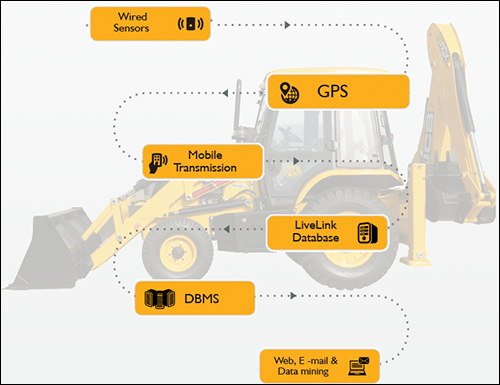For JCB India Ltd., a construction equipment manufacturer based in northern India, revenue comes not just through sales of the backhoes, excavators and other heavy equipment that it manufactures. The company, a subsidiary of U.K.-based J C Bamford Excavators, also generates revenue through its repair and maintenance services arm. But in an emerging market like India, it can be difficult to compete with lower-cost repair and maintenance services offered by third parties. That is one reason JCB India has developed a telematics system known as Livelink, which it has now used to wirelessly connect more than 10,000 of its products to a cloud-based platform designed and deployed on Wipro‘s cloud-based industrial asset-management platform. Wipro is an IT services provider and consultancy based in Bangalore, India.
Through Livelink, JCB India monitors engine health through a device called a telematics control unit (TCU), which is connected to the diagnostics system inside the engine. The diagnostic system collects data on the temperature and status of the engine’s mechanical components and fluids. For example, the TCU collects fuel level, oil pressure, coolant levels and battery status, then transmits this information, along with its GPS coordinates, to the cloud-based Livelink servers, over a cellular network via a SIM card embedded in the TCU. The Livelink software then uses predictive analysis to alert fleet owners to a likely upcoming failure of a specific engine part, or to suggest regular maintenance based on the equipment’s usage history.
Eight out of every 10 service alerts that Livelink generates, based on data collected through Livelink, leads to JCB India performing service work on that vehicle. This has improved the firm’s service revenue, according to N. S. Bala, the chief executive of Wipro’s manufacturing and high-tech industry strategic business unit.
Bala says Wipro began collaborating with JCB India approximately two years ago, and after a series of pilots using after-market TCUs, JCB India now embeds the TCU in each motorized piece of equipment it makes. By alerting fleet owners regarding predictive and regular maintenance, Livelink helps them improve up-time and productivity (especially since the equipment tends to be used in remote areas where a sudden failure could significantly impact a project’s timeline).
However, Bala says, Wipro and JCB India established two other use cases. One involves using Livelink’s location-tracking function to find stolen equipment and to enable fleet owners to ensure that equipment is moved to the proper job site according to schedule. The other additional use case can help JCB India improve its staffing allocations, and is made possible by aggregating the data collected over time on each vehicle’s usage history. “You can look at the backlog of service calls and where and when they happen throughout the year,” Bala explains. This can elucidate when the number of service calls is highest and lowest throughout the year, and where that trend varies regionally. JCB India can use this data to decide how to staff technicians at its various service centers throughout India.
JCB India offers the Livelink service on a monthly per-vehicle subscription basis to fleet owners, who can then access a Livelink dashboard showing the status of all their equipment via a Web interface. The monthly fee also covers the costs of the cellular connectivity.
Going forward, Bala says, JCB India is likely to evaluate some type of local area networking system—perhaps one that leverages mesh-networking protocols—that will enable the TCUs to send data to a central gateway located on each job site, and then use that gateway to transmit the data related to each vehicle in aggregated data packets, rather than the current setup in which each vehicle transmits data directly over a cellular network. The motivation behind such a change would be to lower JCB India’s costs, he says. “A big challenge in many IoT deployments in emerging markets is the cost.” Wipro has already managed to minimize the size of the data packet sent over each SIM card, Bala says, but using a local network to aggregate the data and reduce the number of transmissions sent would lower costs further.



